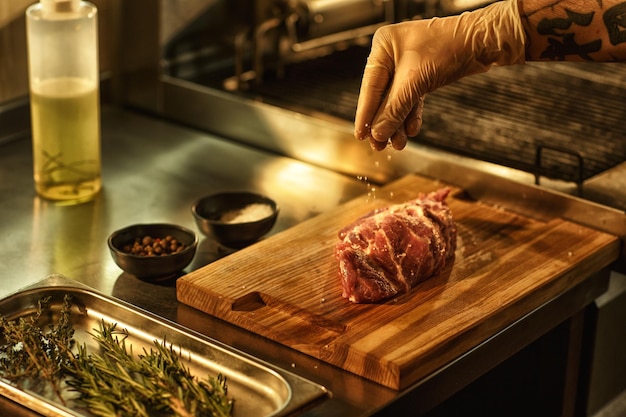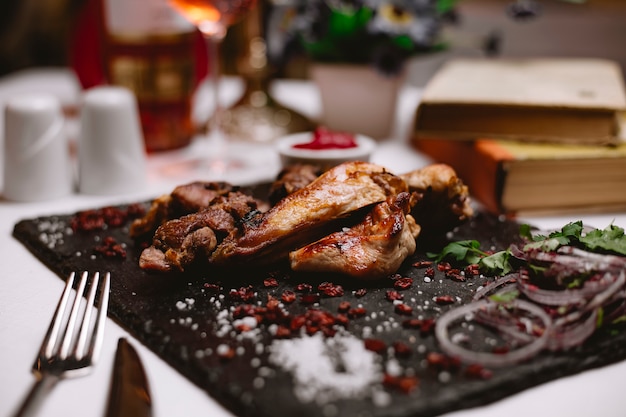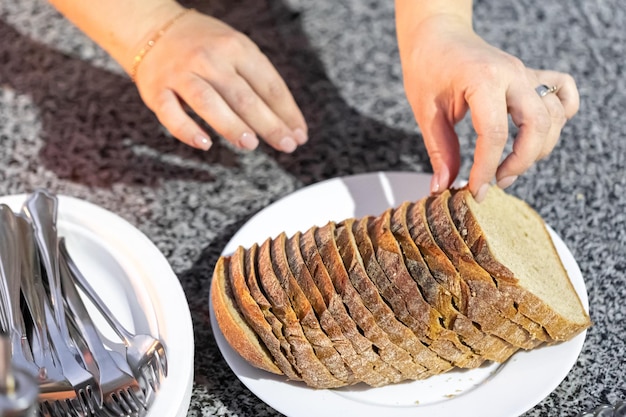We all crave those special meals, those moments where we savor a perfectly cooked piece of meat, bathed in savory juices. For me, prime rib holds a special place in my heart. But, let's be honest, sometimes cooking a huge roast just for two people seems a bit excessive, doesn't it? But fret not, dear friends, because I'm here to tell you that a smaller, perfectly cooked prime rib for two can be just as satisfying and delicious as the big one. It's all about the technique, and I'm going to share my tried and true method with you.
(Part 1) Choosing the Perfect Cut: Prime Rib for Two

Where to Get Your Prime Rib: The Butcher vs. the Supermarket
Before we dive into the deliciousness, we need to find our star player – a beautiful, tender prime rib roast. Aim for a cut that's at least 2 inches thick, and even better if it's closer to 3 inches for a magnificent sear. We're looking for a roast around 2-3 pounds, perfect for two people with a few leftovers for a delightful lunch the next day.
I'm a big fan of my local butcher shop. Not only do they have the freshest cuts, but they're also incredibly knowledgeable. They can help you pick the perfect cut, even trim it down to the exact size you need, and answer all those burning questions you might have. Plus, there's something about the personal touch of a butcher shop that makes the whole experience feel a little more special.
However, if the idea of a quick trip to the supermarket sounds more appealing, don't worry! Many supermarkets have pre-trimmed prime rib roasts in their meat section. Just make sure to check the label for the thickness and weight, and don't hesitate to ask a staff member for help if you're unsure.
The Bone-In vs. Boneless Debate: A Matter of Preference
Now, we come to a crucial decision: bone-in or boneless? This is a personal preference, and both options have their merits. bone-in prime rib is generally considered more flavorful because the bone helps retain moisture during cooking, resulting in a juicy, tender roast. It also gives you those magnificent meaty rib bones to gnaw on, adding a satisfying primal element to the experience (who doesn’t love a good bone to pick, right?).
On the other hand, boneless prime rib is often easier to carve, especially for those who might not be as comfortable with bones. It also makes for a more uniform shape, which might be appealing for presentation purposes.
Ultimately, the choice is yours! I personally prefer the extra flavor and richness of bone-in prime rib, so that's what I usually choose. But if you prefer the convenience and ease of boneless, go for it! There's no right or wrong answer here.
The Fat Factor: Don’t Trim it All!
Here's a little secret that will transform your prime rib: don't trim off all the fat! This might seem like an odd suggestion, but the fat plays a crucial role in keeping the meat moist and tender, adding a rich, delicious flavor. So, leave a nice layer of fat on the roast, just trim off any really thick chunks. Trust me on this one; the result will be worth it!
(Part 2) Seasoning: A Taste of Simplicity

With our perfect prime rib cut, it’s time to add some flavor! I like to keep the seasoning simple and let the natural flavors of the meat shine. But, of course, feel free to experiment with your own favorite herbs and spices.
Salt and Pepper: A Classic Pairing
Salt and pepper are your best friends here. And don't be shy! Salt draws out moisture from the meat, helping to create a beautiful, flavorful crust. You can use coarse sea salt or regular table salt, just make sure to season generously.
For the pepper, I prefer freshly ground black pepper for its intense flavor and aroma. If you're feeling adventurous, try a mix of black and pink peppercorns for a bit of extra flavor and a beautiful visual contrast.
Rub the salt and pepper all over your roast, getting into all the nooks and crannies, making sure every part is coated with flavor.
(Part 3) Resting: The Key to Juicy Meat

Before we even think about the oven, our seasoned roast needs a good rest at room temperature. This crucial step allows the meat to reach a consistent temperature, leading to more even cooking and preventing that dreaded uneven cooking where the outside is cooked through while the inside is still cold.
How long you rest your roast depends on its size. A 2-3 pound roast needs about 30 minutes to come to room temperature. Just make sure to remove it from the fridge about an hour before you plan to start cooking. This gives it enough time to warm up properly.
(Part 4) cooking time: A Guide to Perfect Doneness
Now comes the exciting part – cooking our roast! Prime rib is best cooked to medium-rare, with an internal temperature of 130-135 degrees Fahrenheit (54-57 degrees Celsius). Remember, the internal temperature will continue to rise a few degrees after you remove the roast from the oven, so it's best to take it out a little before it reaches your desired temperature.
Preheat Your Oven to High Heat
First, preheat your oven to 450 degrees Fahrenheit (232 degrees Celsius). This high temperature is key to creating that beautiful, crispy crust on the roast, sealing in the delicious juices.
Searing for Flavor
If you're lucky enough to have a cast iron skillet, this is the perfect time to use it. But don't worry if you don't; a regular baking pan will work just fine. Place the roast in the preheated skillet or pan and sear it on all sides for about 5 minutes per side. This will create a delicious crust and lock in the juices.
Time in the Oven
After the roast has been beautifully seared, transfer it to a roasting pan. If you're using a cast iron skillet, you can keep it in the skillet if it's oven-safe.
Cooking Time: A Guide for Different Roast Sizes
The cooking time will vary depending on the size and thickness of your roast. But as a general rule, you can expect a 2-3 pound roast to take about 45 minutes to an hour.
Here’s a table to give you a better idea of the cooking times for different roast sizes:
| Roast Weight | Cooking Time |
|---|---|
| 2-3 pounds | 45-60 minutes |
| 3-4 pounds | 1 hour - 1 hour 15 minutes |
| 4-5 pounds | 1 hour 15 minutes - 1 hour 30 minutes |
Remember, these are just guidelines. You'll want to use a meat thermometer to ensure your roast is cooked to your desired doneness.
(Part 5) Resting Again: Let it Rest, Let it Rest
Once the roast has reached your desired internal temperature, take it out of the oven and let it rest for at least 15-20 minutes before carving. This is a crucial step in the process! While resting, the juices redistribute throughout the meat, creating a more tender and juicy result.
To keep your roast warm while it rests, you can cover it loosely with aluminum foil. It’s tempting to dive in right away, but trust me, the wait is worth it for that perfectly tender, juicy prime rib.
(Part 6) Carving Time: A Simple Guide
Now comes the moment you've been waiting for: carving the roast. But don't worry, it's easier than you think!
Carving Bone-In Prime Rib
If you're using a bone-in roast, carve along the bone, slicing the meat perpendicular to the bone. This will give you beautiful, even slices. It’s also a good idea to cut between the ribs, removing the roast from the bone.
Carving Boneless Prime Rib
For boneless roasts, simply cut thin slices across the grain. This helps to break down the muscle fibers, making the meat more tender.
Place your carving board on a platter to make serving easier. Use a sharp carving knife to make clean cuts, take your time, and enjoy the moment!
(Part 7) Serving Suggestions: The Perfect Pairings
Now, it’s time to present this culinary masterpiece! Here are some of my favorite pairings for prime rib, both classic and a little more adventurous.
Classic Pairings: A Taste of Tradition
A classic roast deserves classic sides. These are the pairings that always deliver a satisfying taste of comfort and tradition.
- mashed potatoes: A creamy, comforting classic that always goes down well. I like to add a touch of butter and fresh herbs like parsley or chives for extra flavor.
- Roasted vegetables: A medley of seasonal vegetables like carrots, parsnips, and Brussels sprouts, roasted until caramelized and tender, creates a vibrant symphony of flavors.
- green beans: A simple yet elegant side, steamed or sauteed with a touch of garlic or lemon, provides a refreshing contrast to the richness of the roast.
- Yorkshire pudding: A traditional British favourite, this puffy bread, often served with gravy, adds a delightful textural contrast and complements the savory flavors of the prime rib.
Beyond the Basics: Explore New flavor combinations
Feeling a bit more adventurous? Here are some exciting pairings to elevate your prime rib experience to new heights.
- Polenta: A creamy and satisfying Italian dish that complements the rich flavors of the roast. Top it with parmesan cheese and fresh herbs for a touch of elegance.
- cauliflower mash: A lighter and healthier alternative to mashed potatoes, this dish is equally delicious and comforting. I like to add a touch of nutmeg for extra flavor.
- Mushroom gravy: A rich and flavorful gravy that pairs perfectly with the roast and its sides. Use a variety of mushrooms, including shiitake, oyster, and cremini, for a complex and earthy flavor.
- Red wine reduction: This simple sauce adds a touch of sweetness and complexity to the roast. Just simmer a cup of red wine with a tablespoon of butter until it reduces by half, creating a decadent and flavorful sauce.
(Part 8) Leftovers: Don't Waste Them!
One of the best things about prime rib is that it makes fantastic leftovers! The possibilities are endless, from classic sandwiches to surprising soup.
- Prime rib sandwiches: A classic and satisfying way to use leftover roast. Pile the meat onto toasted bread with your favorite toppings, like cheese, pickles, and mustard.
- Prime rib salad: A light and refreshing way to use leftover roast. Simply slice the meat into thin strips and toss it with your favorite salad greens, vegetables, and dressing.
- Prime rib soup: A hearty and comforting soup made with leftover meat, vegetables, and broth. You can add noodles, rice, or potatoes for extra substance.
- Prime rib hash: A tasty and satisfying dish made with leftover meat, potatoes, onions, and peppers. It's perfect for breakfast, brunch, or dinner.
(Part 9) Tips and Tricks: Secrets of the Pros
I’ve been cooking prime rib for many years now, and I've learned a few tricks along the way. These are the tips that have helped me consistently create delicious, perfectly cooked prime rib, so I'm happy to share them with you!
Meat Thermometer: Your Reliable Kitchen Partner
I can’t stress this enough: always use a meat thermometer! It's the only way to ensure that your roast is cooked to your desired doneness. You can buy a digital meat thermometer that will tell you the internal temperature of the meat, ensuring you don't overcook or undercook it.
Avoid Overcrowding the Oven: Give it Space!
Make sure you have enough space in your oven for the roast to cook evenly. If your oven is too crowded, the meat won't cook as quickly and might end up dry.
Keep an Eye on the Roast: Don’t Walk Away!
Don’t just throw the roast in the oven and walk away. Keep an eye on it, especially in the beginning when it’s searing. You want to make sure it doesn't burn and you might need to adjust the cooking time based on your oven and the size of the roast.
(Part 10) FAQs: Your Burning Questions Answered
Q: What if my prime rib is too big for two people?
A: No problem! You can always freeze the leftover meat for later. Wrap the roast tightly in plastic wrap and aluminum foil, and freeze for up to 3 months. Just thaw it in the refrigerator overnight before cooking.
Q: Can I use a different cut of meat for this recipe?
A: Yes, you can use other cuts of beef, such as ribeye or tenderloin, for this recipe. Just adjust the cooking time accordingly. You can find a guide online that will give you the right cooking time for different cuts of meat.
Q: What happens if I overcook the prime rib?
A: Overcooked prime rib can be dry and tough. If you think you've overcooked it, try resting it for a longer period of time. You can also make a gravy or sauce to help moisten the meat.
Q: What if I don’t have a meat thermometer?
A: It's best to buy one! A meat thermometer is a valuable kitchen tool that will help you cook all kinds of meats perfectly. But if you don’t have one, you can try to gauge the doneness by pressing on the roast. medium-rare prime rib will be springy and firm, while well-done roast will be very firm and difficult to press. Remember, this method is not as reliable as using a meat thermometer.
Q: How do I know if my prime rib is done?
A: You can tell if your roast is done by using a meat thermometer to check the internal temperature. Medium-rare prime rib will have an internal temperature of 130-135 degrees Fahrenheit (54-57 degrees Celsius). But if you don’t have a thermometer, you can try the finger test. Press the center of the roast with your finger. If it’s springy and firm, it’s medium-rare. If it’s very firm and difficult to press, it’s well-done.
Remember, cooking a great meal isn't about fancy ingredients or complicated techniques. It’s about choosing good quality ingredients, respecting the process, and having fun in the kitchen. So, go out, get yourself a gorgeous prime rib roast, and let the culinary adventure begin!
Everyone is watching

Corn on the Cob: The Ultimate Guide to Perfectly Cooked Ears
Healthy MealsAh, corn on the cob. Just the name evokes images of sunny days, barbecues, and that sweet, juicy flavour that ...

Perfect Pork Roast Oven Cooking Time: A Guide to Delicious Results
Healthy MealsThere's something truly satisfying about a perfectly roasted pork. The aroma alone is enough to make your mout...

Ham Cooking Time: How Long to Bake, Smoke, or Boil a Delicious Ham
Healthy MealsAh, ham. It's a classic, isn't it? A real crowd-pleaser, especially around holidays. And when done right, it'...

Scallops: The Ultimate Guide to Perfect Cooking
Healthy MealsAh, scallops. Those delicate, sweet, and utterly delicious morsels of the sea. They hold a special place in my...

Spaghetti Squash: The Ultimate Guide to Cooking and Serving
Healthy MealsRemember that time you saw spaghetti squash at the supermarket, looking all bumpy and strange, and thought, "W...
